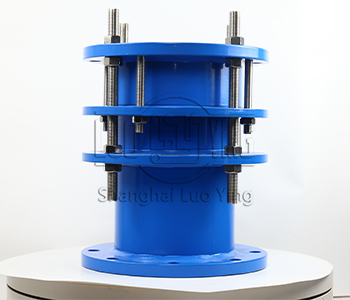The role of double-flanged C-type loose-sleeve force-transferring compensating joints.
Jul-23-21
The role of double-flanged C-type loose-sleeve force-transferring compensating joints.Double-flanged C-type loose-sleeve force-transferring compensating joints play a crucial role in various piping systems and applications where compensation for axial, lateral, and angular movements is required. These joints are specifically designed to absorb and transfer forces and movements while ensuring the integrity and stability of the overall piping system. This article explores the key features and benefits of double-flanged C-type loose-sleeve force-transferring compensating joints.
Key Features:
Design and Structure: Double-flanged C-type loose-sleeve force-transferring compensating joints are designed with a flexible sleeve that allows for axial, lateral, and angular movements. The joints consist of a double-flanged body, a flexible sleeve, and bolts for connection. The double-flanged design ensures secure and reliable attachment to the adjoining flange connections.
Force Transfer and Compensation: These joints are specifically engineered to transfer forces and compensate for movements that occur in the piping system. The flexible sleeve accommodates axial compression and extension, lateral deflection, and angular rotation, thereby relieving stress from the pipes and other connected equipment. This helps to prevent damage and failure in the system caused by thermal expansion, vibration, or ground settlement.
Corrosion Resistance: Double-flanged C-type loose-sleeve force-transferring compensating joints are typically made from stainless steel or other corrosion-resistant materials. This ensures long-term durability and resistance to chemical corrosion, making them suitable for a wide range of industries and applications.
Benefits:
Flexibility and Range of Movement: The flexible sleeve in these compensating joints allows for a greater range of movement compared to other types of joints. They can accommodate axial compression and extension, lateral deflection, and angular rotation, making them ideal for applications where significant movement and flexibility are required.
Stress Reduction in Piping Systems: By absorbing forces and movements, double-flanged C-type loose-sleeve force-transferring compensating joints help to reduce stress and tension in the piping system. This prevents potential damage and extends the lifespan of pipes, valves, and other components of the system.
Improved System Reliability: The use of these compensating joints contributes to the overall reliability and integrity of the piping system. They help to maintain alignment and prevent excessive stress, vibration, and movement, ensuring efficient and safe operation of the system.
Easy Installation and Maintenance: Double-flanged C-type loose-sleeve force-transferring compensating joints are relatively easy to install and maintain. The double-flanged design allows for quick and secure connection, and the flexible sleeve can be easily replaced if needed.

Double-flanged C-type loose-sleeve force-transferring compensating joints are widely used in various industries and applications, including:
Heating, Ventilation, and Air Conditioning (HVAC) Systems
Power Generation and Distribution
Chemical and Petrochemical Plants
Water and Wastewater Treatment Plants
Pulp and Paper Mills
Oil and Gas Refineries
Industrial Pipelines and Process Piping Systems
In conclusion, double-flanged C-type loose-sleeve force-transferring compensating joints are essential components in piping systems that require compensation for axial, lateral, and angular movements. Their design and flexibility enable them to absorb and transfer forces and movements, ensuring the integrity and reliability of the overall system. With their numerous benefits and applications, these compensating joints play a vital role in maintaining the efficiency and safety of industrial processes.

